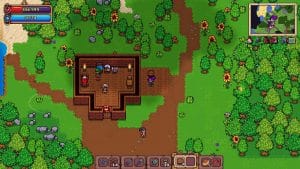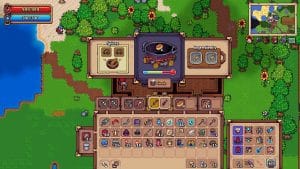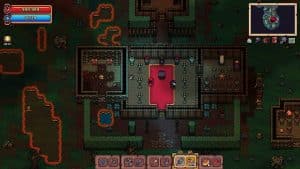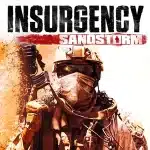Tinkerlands
Related apps
Description
🔥 What is Tinkerlands?
Tinkerlands is a sandbox survival and crafting adventure game developed for PC that blends exploration, creativity, and survival mechanics into a rich, pixel-art world full of wonder and challenge. Set in a procedurally generated realm teeming with both opportunity and danger, Tinkerlands invites players to gather resources, craft tools, and build enduring settlements while unraveling the secrets of a vibrant, dynamic environment.
In Tinkerlands, players step into the shoes of a lone survivor or a group of cooperative explorers cast ashore in a strange, expansive wilderness filled with untamed wildlife, mysterious ruins, and a variety of natural resources. Whether scavenging for rare ingredients, fending off nocturnal beasts, or laying the groundwork for an elaborate homestead, every decision impacts your journey.
The game encourages player freedom, offering the tools to shape your destiny through creativity, tactical thinking, and adaptability. From building intricate crafting stations to taming wild animals and exploring ancient dungeons, Tinkerlands is a multifaceted survival sandbox where your choices define your experience. With its charming aesthetic, engaging systems, and depth of replayability, Tinkerlands is a must-play for fans of games like Terraria, Stardew Valley, Valheim, and Don’t Starve.
👉 Features of Tinkerlands
Procedurally Generated World
Every world in Tinkerlands is uniquely generated with diverse biomes such as lush forests, scorching deserts, icy tundras, eerie swamps, and volcanic mountains. These environments are rich in visual variety and gameplay challenges. You’ll encounter hidden caves, ancient temples, and resource-rich zones that encourage exploration and keep players constantly adapting to new terrain.
Environmental diversity is not just visual it influences gameplay. Snowy areas may require heat sources to prevent hypothermia, while deserts pose challenges with hydration and scarce vegetation. The terrain directly affects how players survive and strategize.
Deep Crafting and Research System
Tinkerlands offers an extensive crafting and research system with hundreds of unlockable recipes. Players begin with rudimentary tools but can quickly progress to forging weapons, building infrastructure, and even designing mechanical contraptions for automated tasks. Research stations allow players to analyze resources and uncover advanced blueprints, adding a layer of scientific progression to the survival loop.
Crafting isn’t limited to necessity it’s also aesthetic. Build elaborate interiors with crafted furniture, customize your character with wearable gear, and decorate settlements with personalized touches. Every crafting choice is an expression of the player’s creativity.
Base Building and Customization
Building is intuitive and highly customizable. Using a grid-based modular system, players can create anything from compact shelters to elaborate villages with defensive walls, communal areas, and farming plots. Structures can be upgraded over time, and special workstations unlock additional utilities like smithing, alchemy, or electronics.
Aesthetic freedom is encouraged through decorative items, color palettes, and themed architecture pieces. Bases can reflect your playstyle utilitarian fortresses, tranquil garden towns, or steampunk-inspired industrial hubs.
In-Depth Survival Mechanics
Tinkerlands isn’t just about building survival is an ongoing challenge. Players must monitor health, hunger, thirst, and energy levels. Seasons dynamically alter gameplay: winters bring food scarcity and longer nights, while summers may cause droughts or wildfires. Environmental effects such as heatwaves, blizzards, or sandstorms add immersion and challenge.
Crafting clothing, preparing meals, and understanding environmental patterns are vital to long-term survival. The game also introduces illnesses, weather-related hazards, and wildlife behavior changes that require proactive planning.
Dynamic Weather and Realistic Day-Night Cycle
The ever-changing environment plays a key role in immersion and strategy. Weather effects include thunderstorms, fog, snowfall, and even magical anomalies in certain biomes. These not only affect visibility and movement but can alter enemy behavior or resource availability.
The day-night cycle isn’t just cosmetic. Different creatures spawn at night, and visibility changes can affect combat and exploration. Building light sources and scheduling your in-game activities based on the time of day becomes part of your planning.
Exploration, Secrets, and Lore
Explorers will find plenty to discover: hidden dungeons filled with traps and treasure, ancient ruins that offer cryptic inscriptions, and scattered journals that unveil fragments of lore. The world of Tinkerlands is rich in narrative clues and environmental storytelling.
Quests and discoveries aren’t always marked on the map. Players are encouraged to explore freely, solve environmental puzzles, and uncover secrets through curiosity and perseverance. The game also includes unique boss encounters and dynamic world events that challenge your preparedness.
Cooperative Multiplayer Mode
Tinkerlands shines in co-op mode, allowing up to 4 players to join forces. Multiplayer adds social dynamics and shared progression players can divide tasks, build massive settlements, and take on tougher challenges together. Coordination becomes key in boss fights, large-scale projects, and resource management.
Voice chat integration, emotes, and shared inventories enhance the multiplayer experience. Whether you’re exploring solo or collaborating with friends, the world reacts dynamically to your presence.
Gameplay
Starting Out
Players start with limited supplies and basic tools. The first hours focus on gathering nearby resources, crafting shelter, and surviving the first night. A soft tutorial guides new players through the mechanics without breaking immersion, allowing for a smooth onboarding experience.
As you progress, new technologies, skill trees, and blueprints open up more complex gameplay paths. Whether pursuing self-sufficiency through farming or specializing in exploration and combat, players can carve out unique playstyles.
Combat and Encounters
Combat in Tinkerlands combines real-time mechanics with strategic depth. Enemies vary from aggressive wildlife to mythic creatures and roaming bandit factions. Weapon variety includes swords, bows, spears, traps, and magical artifacts. Shields, armor types, and movement abilities add tactical options.
Boss battles require preparation and coordination, often occurring during special world events. Combat arenas are sometimes puzzle-based or environmental, requiring players to use the terrain to their advantage.
Farming and Sustainability
Agriculture is essential for stable food and resource production. Players can till soil, plant seasonal crops, and raise animals for meat, milk, and wool. Irrigation systems, greenhouses, and fertilization mechanics allow for complex farming operations.
Crop rotation, weather resistance, and pest control mechanics add realism and challenge. Players interested in long-term sustainability will find farming both satisfying and necessary for progression.
Crafting and Automation
At higher levels, Tinkerlands introduces automation and logistics. Conveyor belts, furnaces, energy nodes, and logic gates enable players to create semi-automated production systems. This opens up engineering-based gameplay for players who enjoy efficiency and design.
Players can specialize in industrial production, creating workshops that mass-produce gear, food, or components for larger community builds. Machines can also be integrated with resource collection, making late-game play incredibly rewarding.
Quests, NPCs, and Events
NPCs populate the world and may appear in settlements or during exploration. They offer trade opportunities, quests, and storylines. Some may even join your community and contribute unique skills or services.
World events include meteor showers, cursed storms, migration waves, and treasure hunts. These moments add unpredictability, requiring quick adaptation and often offering high rewards.
Graphics of Tinkerlands
Retro Pixel Art with Modern Flair
Tinkerlands boasts a lush and detailed pixel art style reminiscent of the golden age of 16-bit games. Despite its retro visuals, the world feels alive thanks to modern lighting effects, particle systems, and smooth animation frames. Environmental design is vibrant and saturated, contributing to immersion and exploration.
Each tile and object is carefully drawn, with biomes differentiated not just by color but by atmospheric effects and terrain style. From glowing mushrooms in caves to misty waterfalls in forests, the game delivers a sense of place.
Environmental Diversity and Details
The game’s world feels handcrafted thanks to diverse tilesets, terrain features, and flora/fauna combinations. Snow accumulates in drifts, leaves fall in autumn, and ambient effects like flickering torches and wildlife chirps reinforce immersion.
The visual storytelling is rich players can spot past battles by broken trees and scorched earth or notice upcoming danger through subtle cues like claw marks or unsettling sound design.
Smooth Animations and Functional UI
Every action from swinging a tool to stirring a cauldron is accompanied by smooth, satisfying animation. The fluidity makes the game enjoyable to watch as well as play. Enemies move with distinct patterns, telegraphing their attacks in fair and readable ways.
The user interface is intuitive and responsive. Inventory, crafting, maps, and quest logs are easy to navigate, even during fast-paced encounters or co-op play. Tooltips and filters streamline management without cluttering the screen.
Optimized Performance and Settings
Tinkerlands is built to scale across various PC setups. It runs well on modest hardware and includes performance sliders for visual effects, resolution, and frame caps. Frequent autosaving, mod support, and customizable keybindings round out its PC-friendly design.
Pros and Cons
✔️ Pros:
- Massive procedural world with deep exploration and lore
- Comprehensive crafting and automation systems
- Rewarding survival mechanics and weather dynamics
- Beautiful pixel art and immersive environments
- Multiplayer co-op for shared adventures and building
- Diverse biomes, creatures, and event types keep gameplay fresh
❌ Cons:
- Complex systems may overwhelm casual players
- Resource farming can feel grindy in solo play
- Lacks structured narrative for those who prefer guided stories
- Occasional AI quirks with NPC pathfinding or enemy behavior
ℹ️ Game information
⭐ Installation Instructions
- The game is fully complete, you just need to install it, so there is no need to unpack it or download it from other sources.
- Just run the Tinkerlands.exe installation file.
- Simply launch the game from shortcut desktop.
⚙️ System Requirements
✅ Minimum:
- OS: Windows 7
- Processor: Intel Core 2 Duo E6320
- Memory: 2 GB RAM
- Graphics: NVIDIA GeForce 7600 GS
- DirectX: Version 11
- Network: Broadband Internet connection
- Storage: 250 MB available space
✅ Recommended:
- OS: Windows 10
- Processor: Intel Core 2 Duo E8400
- Memory: 4 GB RAM
- Graphics: NVIDIA GeForce 510
- DirectX: Version 11
- Network: Broadband Internet connection
- Storage: 250 MB available space
Video
Images









